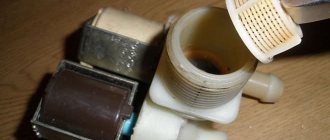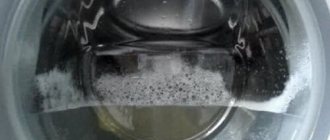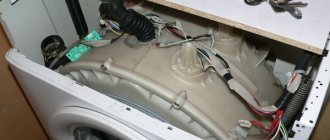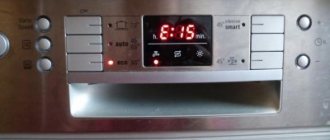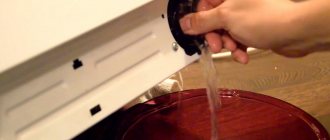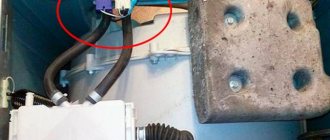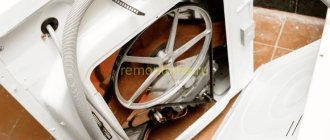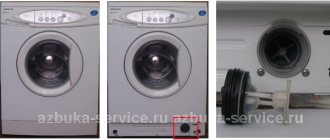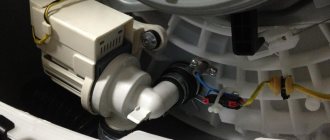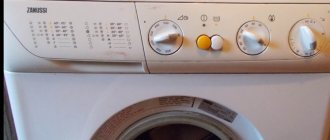An automatic washing machine is one of the most necessary household devices in a household. This is expensive equipment that is purchased for many years, and its breakdown can seriously hit the family budget. Therefore, it is worth understanding what causes various problems and what to do if the washing machine constantly drains water. Many problems can be easily fixed on your own, and knowledge will protect you from unscrupulous repairmen who inflate prices for repairs.
Incorrect or broken hose
The reason why the machine fills and drains water at the same time is that the hose is incorrectly positioned, broken or too low. In this case, the display shows an error code: LE, LC, E9, or LE1.
Such codes are deciphered as “self-draining”, “leakage”. If the machine is not equipped with a display, all wash indicators turn red, except for the cold mode. In devices equipped with an aquastop, a special “float” in the pan reacts to a leak, which immediately gives a signal to stop work.
It is possible that the connection between the hose and the sewer is not secure enough, especially if it has recently been unscrewed. The gasket may be worn out and needs to be replaced.
If such a problem occurs, it is necessary to inspect the floor for the presence of puddles, as well as the hose itself and the place where it is attached to the drain point.
Advice! Before washing, you should carefully inspect items for sharp objects. A small nail or pin in the pocket may fall out and damage the hose when draining.
Errors also occur when too much foam forms in the drum. The reasons are as follows:
- low-quality washing powder;
- overdose of detergent;
- powder not suitable for automatic machine.
The pressure switch reacts to this by displaying an error code.
Attention! If erroneous codes are displayed on the display of a new, newly connected machine, the issue is often resolved by a simple reboot.
Self-removal of the causes of the malfunction
You can correctly determine the cause of the malfunction by performing a full diagnostic of all units and components of the washing machine. To eliminate most problems, you will need the help of a qualified technician, since independent intervention can only cause harm.
Any incorrect operation of the washing machine is evidence of the presence of certain malfunctions of its components and assemblies, which must be eliminated. If the washing machine starts to fill with water and immediately drains, you need to stop it so as not to waste electricity, water and washing powder. In this case, the washing will turn out to be of poor quality, so there is no point in continuing it further. A reasonable option would be to eliminate existing faults and restore the functionality of washing equipment. In addition, there is a risk of flooding of the apartment and damage to property as a result, since the drum of the machine may be overfilled with water due to its improper supply. This malfunction requires mandatory elimination.
You can independently reconnect the washing machine if it was installed incorrectly, clear a clogged drain, and carry out minor repairs that do not require special equipment and tools.
Incorrect connection
When the washing machine fills with water and immediately drains, you should not rush to change the control unit or reflash the system, undertaking expensive repairs. The problem may be a low hose. In order to effectively eliminate such a malfunction, you need to imagine the process of adding and draining water in the machine.
The machine has a tank into which water is poured. At the bottom of the machine there is a pump, which is connected to the tank with a pipe. Through the same pump, water is pumped out of the machine. There is no plug in the hose through which the drain occurs that could hold water. Therefore, when connecting the drain hose to the sewer system, it must be at a height of at least 60–70 centimeters from the floor. Thus, the water will not flow out by gravity.
If the drain point is at floor level, the hose must be raised to a height of 60, or preferably 70 centimeters, secured in a loop and then lowered down to the drain hole. This will create a natural water seal and the water will stop draining. A special clamp for attaching the hose is often included in the design and is located on the back panel of the washing machine.
Attention! If the washing machine constantly fills and drains water, it is worth checking whether the hose is leaking at the connection point to the drainage point (sewer). A thin stream is enough so that the heating element does not have time to heat the water. The program “does not see” this error and sends a signal to constantly add water.
The sewerage system is not functioning
Sometimes the problem is in the central sewer system. More precisely, a blockage occurs or the pressure drops sharply. The latter happens when several residents of the house simultaneously press the drain - the riser overflows, the readings drop, and the liquid from the washer tank is pushed into a common pipe. As a result, the machine empties ahead of time.
You can check whether the sewer system is involved with a simple test. The algorithm for what to do is as follows:
- open any other tap in the apartment;
- evaluate the drainage of collected water (there will be delays in drainage in all rooms).
If there are problems with drainage, then it is necessary to clean the sewer. You can cope with the task either on your own, by pouring special cleaning agents into the riser, or with the help of mechanics. In any case, you will have to wait - the procedure will take a lot of time. In order not to stop the started wash, just unhook the inlet hose from the pipe and lower it into the sink or toilet. The main thing is to thoroughly clean the plumbing fixtures from soap scum and dirt.
Burnt out heating element
The reason why the machine takes in water and immediately drains it, and does not respond to pressing the buttons, may be a burnt-out heating element. In this case, you can turn off the device only by unplugging the cord from the outlet. Such problems occur when trying to use modes with heated water, while the “cold” wash remains working.
This means a malfunction of the heating element - heating element. The control unit does not detect the presence of hot water and does not proceed to the next washing stage after drawing water. This problem often occurs with older car models. In this case, the indicator of new models or “Indezit” equipped with a self-diagnosis system will display an error code.
You can check the correctness of the assumption using a multimeter:
- remove the back cover of the washing machine;
- remove the heating element by carefully prying it off with a screwdriver;
- put the multimeter in dialing mode;
- connect the ends of the multimeter to the two outermost protruding parts of the heating element.
If there is no response from the device, it means that the heating element is broken and must be replaced. You can purchase it at the store and easily install it yourself. The main thing is not to overtighten the rubber band during installation.
Additional causes of problems with heating elements:
- The presence of scale on the device due to hard water. Solution: you need to remove the heating element, soak it in vinegar and remove the plaque with a brush.
- Loose or oxidized electrical contacts. Solution: clean and tighten connections.
- Failure of adjustment in the thermostat responsible for measuring the water level and turning off the heating element. Solution: call a specialist.
Advice! In order for the heating element to serve for a long time, it is necessary not only to make a loop on the hose, raising it by 60 centimeters, but also to make the drain point itself higher by “extending” a piece of pipe to it. This will prevent unnecessary drainage of water, and the heating element will have to work with less load.
How to fix
It is possible to determine exactly what the malfunction is using a comprehensive diagnosis of SMA. If you find a blockage, remove it using available methods.
If it turns out that the intake valve has failed, replace it with a new, working part:
- Unplug the washing machine.
- For a front-loading machine, remove the top cover; for a vertical machine, remove the side panel.
- Carefully disconnect the wires and hoses from the valve.
- Unscrew the screws or bend the latches. There are different types of fixation.
- Turn and remove the valve.
- Install the new part and secure.
- Connect the wires and hoses, securing them with clamps.
- Return the machine panel to its place.
Are you unplugging your washing machine?
Oh yes! No
If the problem is a faulty pressure switch, buy a new sensor. The part is located at the back of the device. After removing the broken water level sensor, inspect it for oxidation of the contacts. They need to be cleaned. To replace you should:
- disconnect the hose leading to the compression chamber from the pressure switch;
- disconnect the terminals and unscrew the screws;
- install a new part;
- connect the terminals and thin hose;
- install and secure the rear panel of the machine.
To replace the heating element, you will need to pull the washing machine out of the niche. Then unscrew the back wall of the device. Locate the heater under the tank.
Check it with a tester in Ohmmeter mode. To replace a part, do the following:
- Disconnect the wiring connectors from the heater.
- Connect the tester probes directly to the contacts of the heating element.
- Measure the resistance, which should normally be 20-30 ohms.
- Loosen the nut of the central bolt and push it inward.
- Using a screwdriver, pull out the heater.
- Insert the new part into the slot.
- Tighten the nut.
- Connect the wiring.
Multimeter
After installing a working heater, check how the washing machine works. Heating elements usually burn out due to a short circuit or the accumulation of limescale.
Troubleshooting problems related to electrical leakage or control module malfunction is best left to professionals. Service center employees have the necessary skills and equipment to perform high-quality repairs of household appliances.
Any malfunction in the operation of the washing machine indicates a malfunction that will not go away on its own. If the equipment collects and immediately drains the collected water, you should not continue washing, so as not to waste resources.
The result of processing the laundry will still not be satisfactory. At the same time, you can flood your and your neighbor’s apartment, since the car’s tank may overflow due to the continuous circulation of water. A breakdown requires prompt intervention by a specialist.
Pressostat malfunction
The washing machine fills an incomplete tank of water and immediately starts draining; the washing process does not start. The reason may lie in the closure of the pressure switch - a water level sensor that shows its quantity in the tank. Its breakdown can be determined by the following typical signs:
- water is constantly pumped into the drum;
- water level too high or too low;
- laundry is not wrung out properly;
- There is always a puddle of water at the bottom of the drum.
If the device gives an error without even starting the wash, the pressure switch may also be to blame: the tube is clogged and needs to be blown out.
By default, the pressure switch has three positions:
- full tank;
- empty tank;
- overflow
When you turn on the machine, the water supply valve starts, and the pressure switch, due to its malfunction, detects an overflow. After this, the upper part of the terminal closes and the water begins to drain. Upon subsequent switching on, the incorrect cycle is repeated. The solution is to replace the pressure switch. For this procedure, you must have the skill to use a screwdriver and pliers.
Important to remember! Each manufacturer of washing machines produces its own type of pressure switch. A sensor for “Samsung” will not fit “LG”, so the part is always replaced with a similar one or one recommended by the company.
Troubleshooting with a guarantee or saving on repairs?
You should not contact your friends or random repairmen - they will not give you guarantees of the quality of the repair, they may install old and substandard spare parts, which means that your claims will not be satisfied.
Manufacturers require compliance with repair regulations, which means that a limited range of spare parts is allowed for installation on the machine. You will not be able to purchase them on your own, because their price for a service center and an individual is noticeably different.
The cost of repair depends on what parts had to be replaced after diagnosis. It can be calculated after the technician finds the cause of the malfunction and accurately determines the list of spare parts for replacement.
Our service center specialists use only new and conditioned components that are covered by the manufacturer’s warranty.
Intake valve failure
The inlet valve is a device that automatically controls the flow of water into the washing machine. Therefore, if it stops taking in water, it could mean the inlet valve is broken.
Intake valves are divided into several types:
- single-section (found in old-style devices);
- double;
- triples.
The latest types of valves are installed in electronically controlled machines.
A failed valve cannot be repaired and must be replaced with a new one. Before replacing, you should check it for blockages or using a multimeter. The resistance of the working valve will be 2–4 kOhm.
The washing machine does not hold water - should I call a professional?
In this case, you need to call a specialist! Even if the problem is due to unrelated reasons, there is a high probability that your washing machine has been working for a long time. It is necessary to check the condition of the pump, valves and hoses.
If, as a result of diagnostics, it turns out that the cause of the water drainage was a pressure switch or valve, then these parts must be replaced with new ones. They cannot be rebuilt or restored. You will not be able to save on machine repairs if such a malfunction occurs - the consumption of water and electricity due to the constant set and increase in the duration of the wash will be enormous.
Blockages
Clogging is one of the most common causes of washing machine failure. Over time, the filters become clogged and scale forms on them. Filters are divided into two types: drainage and inlet.
Note. Input filters break down especially often in machines.
Signs of blockages in the filter:
- unpleasant odor emanating from the device;
- slowly collecting water and draining it.
Step-by-step cleaning plan:
- input filter:
- turn off the water supply tap to the washing machine;
- disconnect and pull out the hose;
- pull out the filter;
- rinse the filter under strong water pressure;
- Insert the clean filter mesh back and press it along the edges;
- assemble the system and check for leaks.
- drain filter:
- open the lower hatch on the front panel;
- disconnect the hose;
- place the container and drain the remaining water;
- Pull out the filter in a circular motion;
- rinse the filter under running water;
- install the part back;
- turn the machine on to the “drain” mode and check for leaks.
To prevent blockages, you should clean the filters at least once every 2–3 months. The dirt trap socket, as well as the place where the filters are installed, must also be cleaned. Such simple care can extend the life of the machine for many years.
Fill valve open
The washer will constantly drain water even if there are problems with the inlet valve. The logic is simple: if the machine takes in too much water, the pressure switch will signal an overflow, and the board will give the pump a command to drain. You can stop “self-draining” by adjusting the filling system. Typically, the valve mechanism needs to be repaired or replaced.
You can deal with the inlet valve at home. Do-it-yourself repairs take place in several steps:
- buy a similar valve and removable clamps for fixation;
- disconnect the machine from communications;
- remove the top cover if the machine is front-loading, or the side wall of the “vertical” machine;
- find the valve installed at the connection point of the inlet hose;
- free the device from connected wiring and pipes;
- unscrew the fasteners, remove the clamps;
- turn the valve and remove it from the body;
- install a new device.
The new valve is fixed with clamps, after which the pipes and wires are connected. The quality of the repair is checked by a test wash.
What it is not recommended to do on your own
Anyone who has minimal skills in handling modern technology can handle minor repairs to a washing machine. But when it comes to failures in electronic hardware or software, the repair should be entrusted to a professional.
You cannot repair it yourself:
- complex electronic modules;
- relay;
- sensors
Almost every person is able to understand the simple causes of a washing machine malfunction and eliminate them. An attempt to fix a serious breakdown on your own entails unpleasant consequences both for the device and for the owner himself.
Self-diagnosis
Modern washing machines are smart technology. Although it doesn’t seem so, if the washing machine fills with water, immediately drains and then turns off, for example. This behavior is senseless, stupid, irrational, it’s hard to say otherwise. Indeed, water should not be wasted in such quantities. On the contrary, the manufacturer promised that water would be saved. The counter is spinning, the washing machine is not behaving correctly. What is the reason? What to do? Breakdown is expensive - that's obvious. Water and detergents are wasted. But, most likely, the malfunction is not serious.
In the near future, a washing machine will harmoniously complement a smart home, in which most of the processes will occur automatically, and a person’s life will turn into a fairy tale, it will become more interesting and easier to live. Economically consumed water, electricity, natural resources, proper disposal - I want to make all this part of the future, to give a green planet to my descendants and heirs. For now this is a goal, a dream. Technologies are just developing, but the washing machine claims to be the ideal technology of the future today. It’s scary if it fills and immediately drains water, refuses to wash, turns off, or continues meaningless actions. How can you help your favorite equipment?
After purchase, the washing machine will be delivered to the specified address, placed in the kitchen or bathroom, but the owner must connect it independently, in accordance with the instruction manual. Naturally, many connection nuances may not be included in the instructions. Each situation is individual. You can also count on the help of a plumber only sometimes. By and large, it is the owner’s responsibility to connect the washing machine. It is difficult to call it part of a water supply or sewer system. Such a service must be negotiated individually. This is inconvenient, the bet is that in the basement of a residential building, for example, there will be a row of washing machines and laundries will open. While there are no such laundries, you should do it yourself or call a specialist who has the time; installation is included in the list of services.
Diagnosing problems is one of the tasks that you can handle on your own. If the washing machine has given alarm signals before, you should take them into account. Smart technology must be handled with confidence. She still won't outwit a person.
What to do to avoid machine breakdown?
Washing machine care and maintenance
Proper and timely cleaning of its components is extremely important for reducing the consumption of washing powder and good functionality of the machine. Certain parts of the unit constantly require cleaning, namely: the door seal, the filter, the mesh on the supply pipe.
Proper washing. How to wash bed linen?
Of course, before washing, laundry needs to be sorted. Proper sorting by color and material will help the laundry maintain its original appearance and make life easier for the washing machine.
If the laundry is not dirty and the goal is simply to freshen it, it is necessary to use the cold mode and a short, not complete program. By following these simple rules, you can save energy and take care of your machine drum.
Damage during which a household appliance collects and immediately drains liquid
Let's consider what possible breakdowns lead to the consumption of large amounts of water. At the same time, they take into account the fact that special equipment is used for diagnosis and repair. Therefore, even after testing and finding a problem, they call a specialist who will eliminate all the causes in a matter of hours, and the machine will begin to work correctly.
| Problems | What is the matter or what is “to blame”? |
| Water level sensor is faulty | The pressure switch must determine the amount of water in the tank and give a command to the valve to fill it. Whether the machine is full or not, the sensor can “understand” by the pressure. Let's look at why he doesn't do this. If the pressure tube is clogged or scale has formed on it, then the pressure switch does not supply the “correct” signal. This means that the machine takes in water, but immediately drains it. If the contacts of the water level sensor are oxidized, this may also be the reason for the washing machine to not operate properly, since in this case they may short out, causing the pressure switch to stop functioning. Also, the quality of its operation is greatly influenced by a leaky membrane. Sometimes the valve and hose fail. In this case, the household appliance will be constantly refilled and proper diagnostics and repair will be required. The specialist simply replaces the sensor. |
| Valve failure (exhaust) | If the valve stops working, that is, the water does not shut off, then perhaps the membrane has weakened, and therefore liquid will leak out even when the valve is closed. The specialist replaces it with a new one. |
The correct installation of the drain hose can be checked visually without washing: its upper bend is fixed above the mark of the washing machine tank - a distance from the floor of 0.5 m. This position prevents constant draining of water. Otherwise, the level decreases, the sensor reacts and gives the command to fill the liquid. The situation will persist until the set program expires. The problem can be easily resolved:
- 1. The machine comes with a plastic curved hose holder. It is mounted on the back wall of the device or on the edge of the bathtub or sink.
- 2. Discharge into the sewer is done through a sanitary siphon with a special outlet for connecting the washing machine hose. This connection complies with the manufacturer's requirements.
If the hose is inserted directly into the sewer pipe at floor level, this causes the water to drain itself. In the absence of a check valve in the liquid discharge from the machine, a siphon effect sometimes occurs. The vacuum that occurs in the riser during intense drainage can cause suction through the hose connected to the system, and water will leave the tank during washing. You can avoid this: disconnect the hose from the sewer pipe and lower it into the bathtub.
We recommend: Oil heater: breakdowns and how to repair them yourself
Why does this happen?
If the washer fills with water and immediately empties the drum, this is immediately noticeable. Firstly, the cycle does not end at the appointed time. Secondly, noise is constantly heard from the machine without stopping the running sewage system. Thirdly, the laundry loaded into the machine remains dirty.
The following reasons lead to this situation:
- improper installation of the drain hose;
- sewer blockage;
- malfunction of the drain valve;
- faulty pressure switch;
- failure of the control board.
Modern Indesit models, if there is a problem with water collection, automatically turn off the cycle and display the corresponding error on the display.
The problem with water filling must be resolved immediately . Uncontrolled drainage negatively affects all elements of the drainage system, jeopardizing the pump, pipes and valves. There is also a high probability of leakage, short circuit and flooding of the apartment.
The equipment is clogged
Malfunctions in the drainage system are also possible due to blockages. If dirt has accumulated in the pipes, on the impeller or in the pump, the pump functions chaotically, which leads to water draining from the tank unplanned by the program. To eliminate the malfunction, it is necessary to clean the garbage filter and other filtering elements of the machine.
Getting to the filtration system is easy.
- We disconnect the machine from communications, power supply and water supply.
- We find a technical hatch in the lower right part of the case, carefully pry it up with a screwdriver until the latches engage and remove it.
- We grab the protruding part of the garbage filter (the black “washer” located on the right edge) and unscrew it by turning your hand counterclockwise.
- We rinse the spiral under running water.
If the garbage filter is covered with a thick layer of scale, then it is better to soak it in a warm solution of citric acid for 30-40 minutes.
- We shine a flashlight through the vacated hole and inspect the degree of contamination of the impeller, volute and pipes.
If the technical hatch cannot be opened, then we try to check the drain differently. Having disconnected the machine from all communications and moved it to the middle of the room, carefully turn the unit onto its right side and look through the bottom. As a rule, washing machines from Indesit do not have a bottom, which facilitates the diagnostic process.
